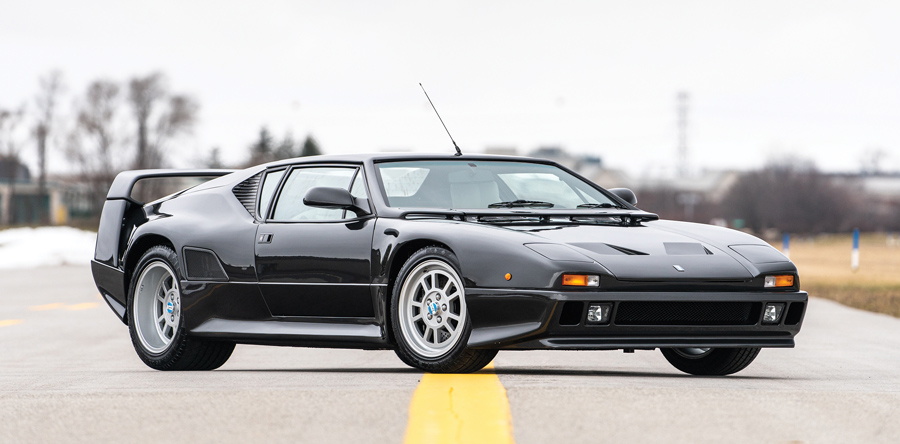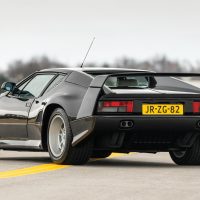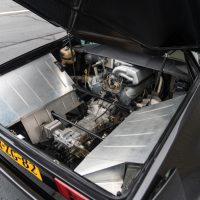SCM Analysis
Detailing
| Vehicle: | 1991 DeTomaso Pantera 90 Si |
| Years Produced: | 1990–93 |
| Original List Price: | $80,000 (approximately) |
| SCM Valuation: | $290,000 |
| Tune Up Cost: | $350 |
| Chassis Number Location: | Top edge of dashboard |
| Club Info: | Pantera International |
| Website: | http://www.panterainternational.org |
| Alternatives: | 1991 Ferrari Testarossa, 1991 Lamborghini Diablo, 1991 Porsche 911 Turbo |
| Investment Grade: | B |
This car, Lot 32, sold for $357,000, including buyer’s premium, at Gooding & Company’s Amelia Island, FL, sale on March 6, 2020.
The impact on the automotive world that Alejandro DeTomaso has had is quite a bit larger than the total output of all the cars for which he was responsible. And that’s saying quite a bit, as it was thanks to him that Maserati became a truly mass-market company — for better or worse — with the launch of the Biturbo coupe in 1981. So, in addition to being a niche sports-car builder, DeTomaso also had a vision of global marketing not often found among the dreamers who start car companies.
By the time Ford pulled the plug on the Pantera cooperative marketing venture in the U.S. market, DeTomaso had already set his sights on Maserati, and he took over the ailing company in 1975.
As he had a large company like Maserati to sate his greater ambitions, DeTomaso was free to keep tinkering with the Pantera after it had ceased being a volume product. This accounts for the extraordinary 22-year run of the car, despite ever-declining production numbers. Through those decades, however, the Pantera was hardly a static object.
So, today as a collectible, there are Panteras, Panteras and then there are Panteras.
Different versions
The first Panteras are the Ford-marketed launch cars, especially those with the delicate chrome bumpers and mechanicals as close to as-delivered stock as possible. A subset of those are the later rubber-bumper models, which may or may not have been uprated and modified to deliver much more performance than they did in the 1970s. Next are the private-import or period “gray market” imports of the Pantera developments DeTomaso sold after the cars left the U.S. market.
These cars, largely the GT5 and GT5-S, have also often been modified by their original or subsequent European owners to suit their tastes, preferences and pocketbooks. In addition, there are the early cars which have been made into clones of the GT5.
Finally comes the swan song, the Si. Unlike the earlier models, the Si is a much more dramatic departure from the Tom Tjaarda-designed original of 1971.
The Pantera Si
The Pantera Si is quite different from the earlier versions — and not simply in design. Marcello Gandini did a very fine job of transforming the Pantera of 1971, which I love, into a thoroughly modern and much more aggressive machine. The integration of the somewhat Ferrari F40-like rear wing into the body is quite brilliant, and the overall effect is miles ahead of the “bolt-on flares” look of the GT5 or the somewhat “Countach Anniversary” look of the GT5-S.
All this makes the Si a very different animal indeed from its earlier brethren — and a very special piece of the DeTomaso story. As Pantera production went on, and yearly production numbers diminished, the cars became steadily more hand-made and more packed with the creature comforts and finish details expected in a limited-production car.
This was also due to the fact that the prices rose dramatically from the Lincoln-Mercury dealer’s $10,000 MSRP to the $71,000 of the GT5-S.
Originality counts in a rare car
So, we’ve established that all the post-Lincoln-Mercury Panteras are rare and were expensive when new.
The collector-car market today generally — and that’s important — rewards the original and punishes the modified. There are exceptions, but they are usually to be found in mass-production classics of the 1950s and 1960s, where, in recent auctions, average restored original cars have sold for less than well-done resto-mods.
But we’re dealing with rarity here. And when it’s rare, originality counts.
The Pantera Si is such a rare car, so it’s interesting that in a very short time we’ve seen two come up for major land-auction sale. In August 2019, RM Sotheby’s sold a 26,000-mile Pantera Si for $240,800 in Monterey. Seven months later, we have our subject car selling at $357,000.
The extremely low mileage of our subject car is what makes the difference between the two sales. As described in the catalog and observed by me in the auction preview, the car presented as basically new. Especially with a white leather interior and Quattroporte III-type burled-wood interior accents, which were almost unblemished — plus unused tools, all books, the works.
For the collector who prefers their automotive objects unexercised, a more compelling example could not be imagined.
I, for one, would like to drive this very car, but it’s unlikely to see the open road in the near future. Nevertheless, it sold appropriately for the object that it is.
Out subject car is also a world record for a Pantera. Perhaps it’s surprising that it was not much higher than the previous record of $319,000 for a Pantera GT5-S at Gooding & Company in January 2018. ♦
(Introductory description courtesy of Gooding & Company.)



